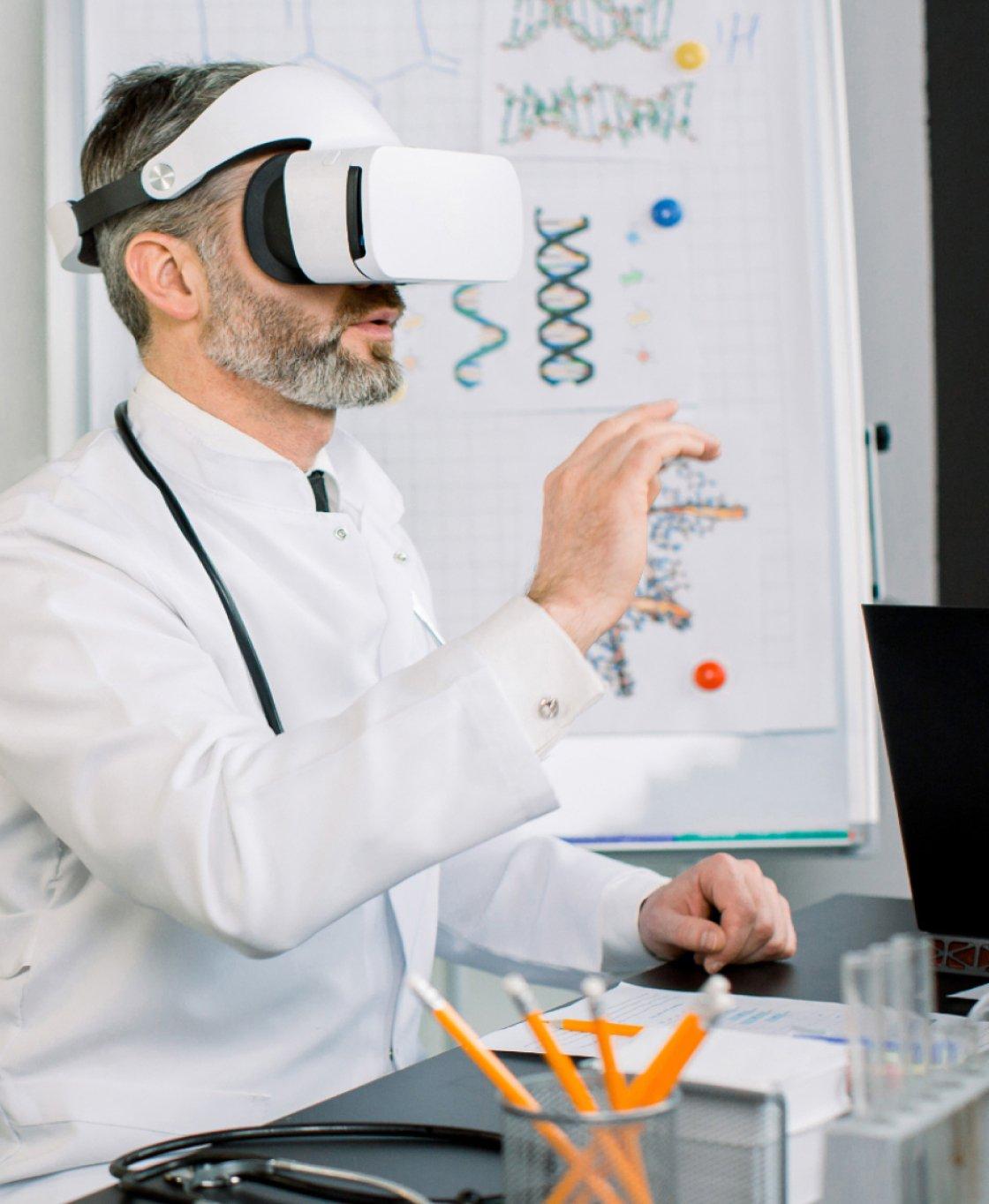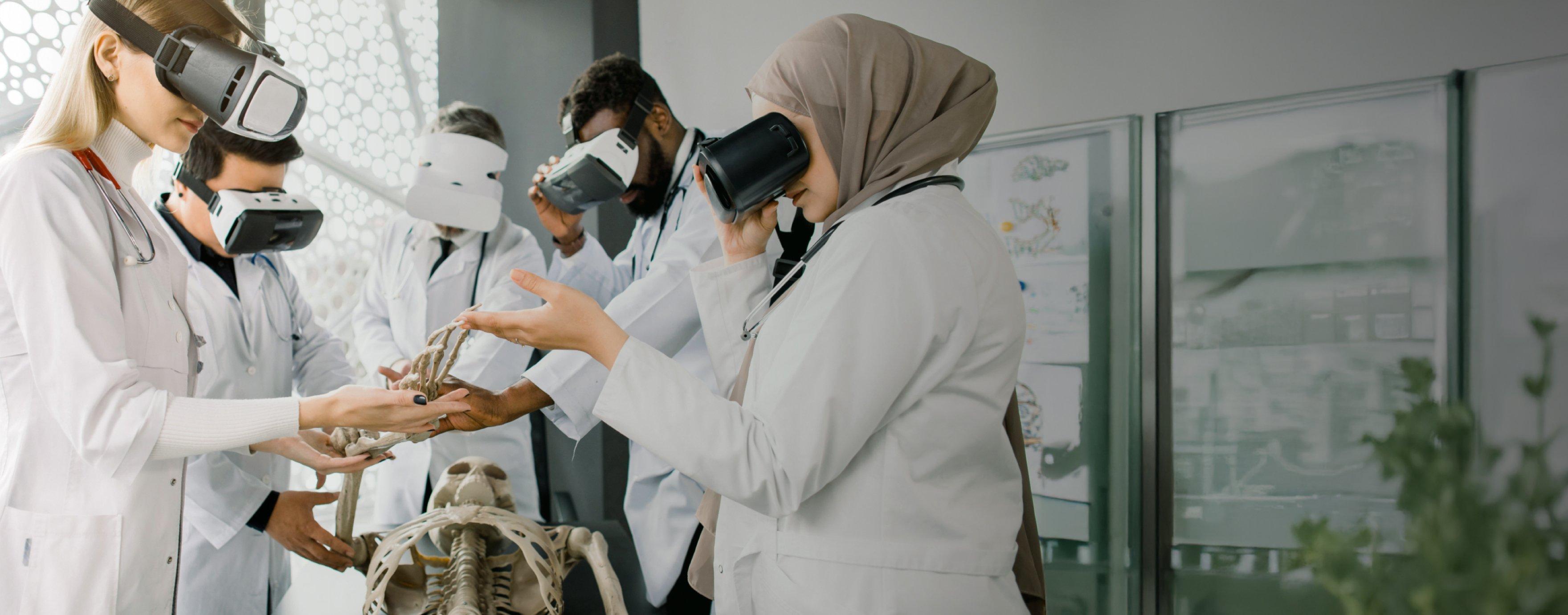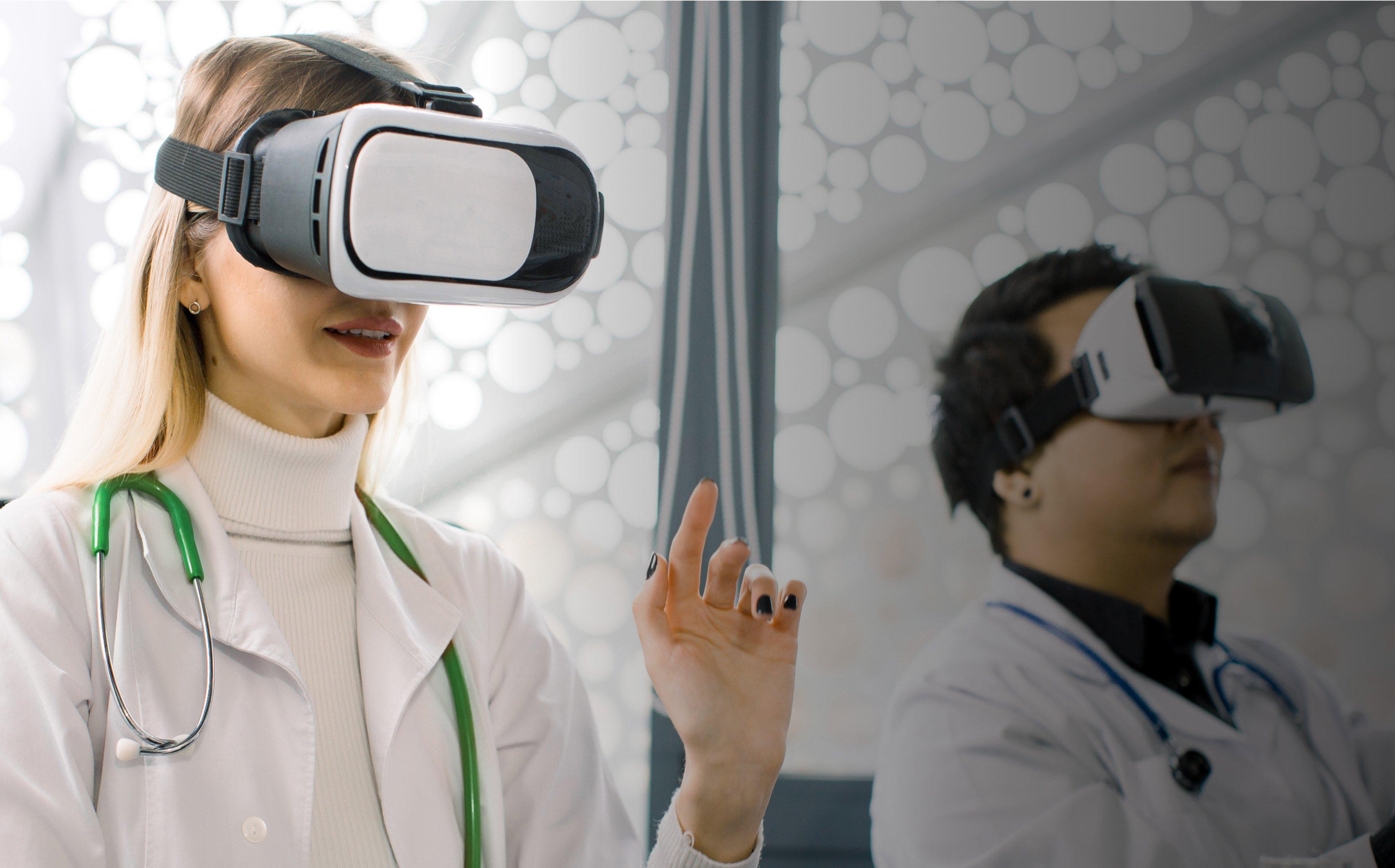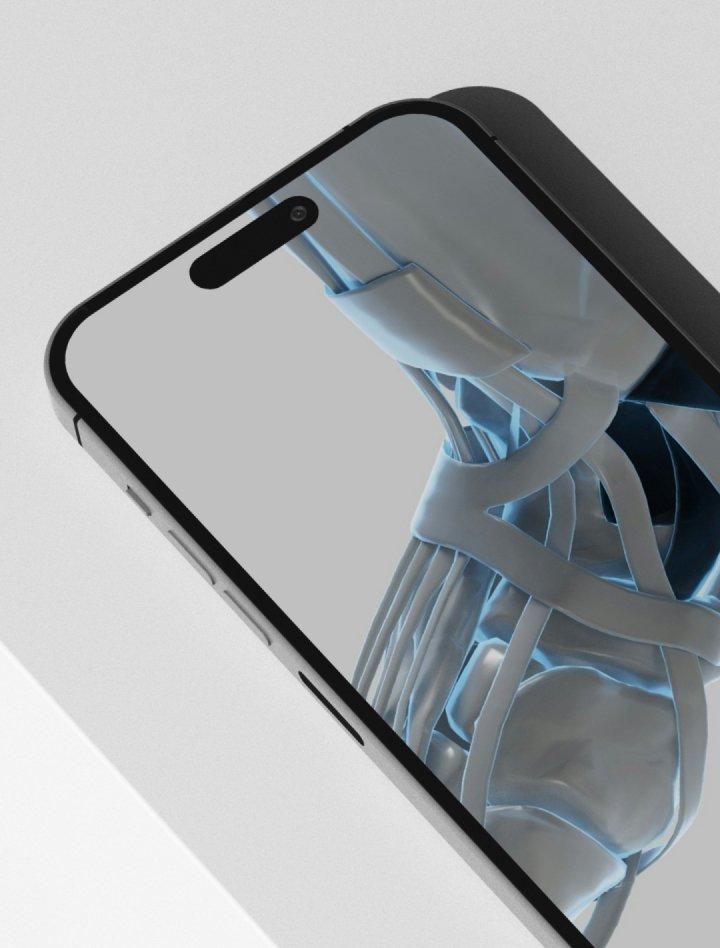Virtual reality in medical training and education: How to make your vision a reality
Through life-like simulations and immersive training experiences, virtual reality (VR) technology has revolutionized healthcare education and training with transformative solutions.
We’ve seen it firsthand: With over a decade of experience in virtual reality software development, Vention has partnered with diverse healthcare organizations to optimize their learning processes and amplify learning efficiency.
And now, we have the expertise to help you harness the power of VR — whether it’s transforming your training programs, enhancing learning outcomes, or creating immersive experiences that set a new standard in healthcare education.
VR is a game-changer for medical training and healthcare education
VR training in healthcare is thriving, and the numbers prove it. The VR healthcare market is set to skyrocket from $4.18 billion in 2024 to $46.37 billion by 2032, growing at an impressive CAGR of 35.1 percent.
A recent Virti survey paints a compelling picture of VR in the healthcare industry: 34 percent of organizations have already adopted VR for training, and 43 percent plan to implement it soon.
Meanwhile, a survey by Vive highlights the transformative power of VR for medical training:
- Ninety-one percent agree that VR enhances educational programs.
- Eighty-four percent involved in purchasing VR training solutions “like” or even “love” the deployments they’ve approved.

What’s the future?
Among organizations that haven’t yet embraced VR, 86 percent expect to adopt it by 2026.

Many prestigious medical schools and teaching hospitals around the world, including Johns Hopkins University and Harvard in the US and the UK’s University of Oxford, have embraced virtual reality in medical education technology to train students, doctors, and healthcare practitioners in new skills in a safe and immersive educational environment.
Governments have also noticed the technology's benefits, with the EU sponsoring short-term roadmaps to increase the availability of VR medical products and services in Central Europe.
Use cases: A macro view and in-depth insights
VR training in medical education opens enhancements in five main directions:
- Anatomy exploration
- Procedural rehearsals
- Emergency management
- Patient interactions
- Team collaboration
Explore the specifics of how these use cases function across various medical specialties for educational purposes:
VR in surgical training
- Master technical skills: hand-eye coordination, precision, and instrument handling.
- Practice decision-making under pressure and effective teamwork.
- Rehearse a wide range of procedures — from routine surgeries to rare, high-stakes cases.
VR in emergency training
- Hone decision-making under pressure and stress.
- Train for rare scenarios like natural disasters.
- Refine multidisciplinary team collaboration.
VR in cardiology
- Simulate routine and complex procedures such as angioplasty, cardiac catheterization, and valve repair.
- Navigate cardiac anatomy with 3D models.
- Handle emergencies, such as heart attacks or cardiac arrest.
- Repeatedly practice the management of rare cardiac conditions, such as congenital heart defects.
VR in anesthesiology
- Practice handling complex scenarios, such as airway complications or allergic responses.
- Rehearse intubation and other critical procedures.
- Develop patient monitoring skills like recognizing heart rate changes or allergic reactions.
- Learn dosage calculations and anesthesia management, including for high-risk patients.
VR in orthopedics
- Practice procedures like joint replacements and fracture fixations.
- Learn new surgical techniques, including robotic-assisted surgery.
- Simulate deformity corrections or highly challenging trauma cases repeatedly.
- Plan and perform high-stakes surgeries with less risk, thanks to 3D modeling.
VR in neonatology
- Simulate newborn resuscitation.
- Repeatedly practice the management of both routine and rare conditions like respiratory distress or sepsis.
- Simulate high-pressure scenarios requiring multidisciplinary collaboration, including neonatologists, nurses, and respiratory therapists.
VR in psychiatry and mental health
- Simulate clinical scenarios, such as schizophrenia, anxiety, and autism spectrum disorders, to refine diagnostic accuracy.
- Practice communication skills: empathetic listening, negative news delivery, and sensitive topics discussion.
- Train in crisis intervention for scenarios like acute psychosis.
VR in gynecology
- Practice routine procedures, such as pelvic exams, Pap smears, and ultrasounds.
- Handle complex conditions, including cancers and endometriosis.
- Learn how to deliver complex topics like infertility, miscarriage, or cancer diagnoses.
- Master IVF procedures.
- Train for diagnostic accuracy using virtual imaging like ultrasounds and MRIs.
VR in radiology
- Visualize anatomical structures in 3D for enhanced spatial awareness.
- Practice accurately interpreting CT, MRI, and ultrasound images and identifying normal and abnormal structures.
- Diagnose acute conditions and life-threatening injuries on X-rays, CT scans, or MRIs.
- Simulate interventional radiology procedures like biopsies and catheterizations.
VR in nursing
- Practice essential skills such as wound care, catheter insertion, and IV setups.
- Train for advanced nursing procedures, such as managing central lines and tracheostomies.
- Handle emergency scenarios such as cardiac arrest and respiratory failure.
- Prioritize care based on severity.
VR in ophthalmology
- Simulate surgeries like cataract removal and retinal repair.
- Practice minimally invasive procedures and diagnostic exams, such as fundoscopy.
- Train for managing eye conditions like glaucoma and macular degeneration.
- Enhance patient communication, especially to alleviate anxiety related to vision loss.
- Simulate and manage cases involving ocular trauma, including penetrating injuries and chemical burns.
VR in otolaryngology
- Practice ENT surgeries like thyroidectomy and sinus surgery.
- Diagnose common ENT issues like middle ear infections and more complex ones like vocal cord lesions.
- Simulate emergency responses for airway obstructions, foreign bodies, and allergic reactions.
- Repeatedly practice lifesaving procedures, such as tracheostomy or cricothyroidotomy.

Ready to bring your VR training app to reality?
Whether you’re building from scratch or fine-tuning an existing solution, our team can virtually make it happen. Leverage our hands-on expertise in VR for healthcare.
How VR advances traditional medical training techniques
Whether mastering intricate procedures or preparing for critical emergencies, VR offers medical students and practitioners a safe environment to gain hands-on experience — free from the stakes of real-world scenarios.
VR closely replicates real-world scenarios, bridging the gap between theory and practice in medical training. VR lets trainees visualize and manipulate highly detailed 3D models of vessels, bones, organs, and tumors.
Realism is also achieved thanks to 3D models of medical equipment and environment and haptic feedback.
With highly interactive, lifelike simulations, VR allows students and practitioners to hone critical decision-making abilities, develop or refine procedural skills, and experience rare medical situations — all in a controlled environment.
VR eliminates the need for expensive (and often single-use) training equipment and biological models. Instead, it favors applications that can be run as many times as desired by multiple trainees simultaneously.
A comparative cost analysis of VR-based training for neonatal intensive care workers versus live disaster exercises with mannequins reveals an interesting trend. Initially, VR training costs $327 per participant, while traditional drills only cost $229. However, over time, VR has become a more economical choice. Spread over three years of repeated training, the cost per participant drops to just $115, while live drills stay at their initial price.
The study by PWC also highlights the cost-efficiency of VR-based learning on a large scale. With 375 learners, VR training demonstrated cost parity with classroom learning, while with 3,000 learners, VR becomes 52 percent cheaper than classroom sessions.
VR training is remote-friendly: Students can practice and learn wherever convenient. This flexibility attracts participants who might not otherwise attend physical classes, broadening access to healthcare education for diverse learners and professionals.
Well-designed VR apps include tools to track user actions, movements, and decision-making during virtual procedures. This data supports objective evaluations, detailed feedback, and personalized guidance, helping users improve skills efficiently and effectively.
Remarkable success stories of virtual reality in medical education
Over the past decade, numerous VR medical training platforms with unique features and innovative approaches have set themselves apart. Here are some of the most notable examples:
Oxford Medical Simulation (OMS) is a medical education platform that focuses heavily on virtual reality simulations, particularly in the soft skills needed to interact positively with patients (think patient management, communication, and clinical decision-making).
Over a dozen American universities and the UK’s National Health Service use OMS, which allows medical professionals to practice patient management, communications skills, and clinical decision-making in simulations designed to enhance diagnostics and patient care abilities.
The reported ROI of Oxford Medical Simulation's VR training ranges from an impressive 120 percent to a staggering 3,000 percent.
Level Ex is a gamified medical training VR app that blurs the line between gaming and education. As a leading medical video game studio, Level Ex goes beyond the basics of VR in medical education. It delivers progression-based systems based on medical specialization, skill, and overall goals, with over a million medical professionals using its products.
Virti delivers a 230 percent increase in hard skills knowledge by integrating AR and VR into learning experiences. With interactive simulations, virtual environments, and personalized feedback, Virti provides training in complex clinical skills and surgical procedures, making it a leader in experiential learning.
Harvard Medtech takes a unique approach, focusing on helping patients overcome trauma-related barriers through VR. To support patients, doctors first learn the platform themselves, using a methodology that enhances empathy and communication skills for healthcare professionals working remotely.
How much does VR software for medical training cost?
If you're concerned about the affordability of VR training apps, take a closer look at the sample features and cost ranges below. These figures are provided as general benchmarks, not binding offers. By examining the possibilities, you can better understand what aligns with your budget and objectives.
Basic VR training app
$50,000–$70,000
Mid-level VR training app
$100,000–$150,000
Complex VR training app
$200,000+
Models
Basic VR training app
$50,000–$70,000
Simple models with basic textures
Mid-level VR training app
$100,000–$150,000
Moderate detail with realistic textures
Complex VR training app
$200,000+
High realism with dynamic lighting
Scenario complexity
Basic VR training app
$50,000–$70,000
Single scenario
Mid-level VR training app
$100,000–$150,000
Scenarios with predefined paths, several scenarios available
Complex VR training app
$200,000+
Multiple scenarios with adaptive learning paths based on user performance
Interactivity
Basic VR training app
$50,000–$70,000
Moving objects, making decisions, or selecting items
Mid-level VR training app
$100,000–$150,000
Physics-based interactions, like taking objects.
Audio and visual cues
Complex VR training app
$200,000+
Highly interactive, e.g., you can take an object and look at it at any angle
Analytics
Basic VR training app
$50,000–$70,000
Minimal to no analytics
Mid-level VR training app
$100,000–$150,000
Basic metrics like completion time and accuracy
Complex VR training app
$200,000+
Interactive and intuitive user charts
What else can add to the costs:
- Hardware and licensing
- Hardware-specific requirements to the level of detail and interactivity (e.g., Apple Vision Pro demands exceptional quality right from the start. Meta Quest, on the other hand, offers more flexibility. You can launch a functional prototype and refine the product iteratively).
- Need for custom VR development rather than adapting an off-the-shelf VR training solution.
- Multiplayer mode
- Haptic feedback
- Compatibility with multiple VR platforms
- VR app integration with hospital systems, eLearning platforms, or other software
- Ongoing solution maintenance (amounts to around 10 percent of the development cost annually)

Your app, your way
Let’s design a VR solution tailored to your unique goals and budget.
How to build a medical training VR app
To move seamlessly from VR app planning to deployment, you (or your development partner) need a powerful blend of VR expertise and deep healthcare insight.
Based on our experience, we’ve outlined key steps to guide you through this process.
Discovery
VR consultants thoroughly analyze your goals, existing training materials and procedures to suggest best-suited use cases. They factor in medical specialties specifics and training scenarios to benefit your target audience — be it medical students or practitioners.
Design
At this stage, the work unfolds in multiple directions. Engineers design scalable architecture to support future user growth and integration of new features. Meanwhile, UI/UX designers plan user journeys and interactions and shape the training content by outlining learning paths.
Virtual reality app development
If 3D models of anatomy, instruments, or environments need to be created from scratch, collaboration with subject matter experts begins. When pre-built models suffice, experts carefully select best-fitting options.
VR engineers build the app, delivering every planned feature, whether it's the simplest training analytics or haptic feedback.
Integration
It’s time to connect your VR training app with the required internal and third-party systems like learning management, medical imaging software, medical content libraries, simulation devices, and payment and subscription systems.
Solution testing
Subject matter experts verify the realism of 3D models and the smoothness of navigation through learning paths. On the technical side, QA experts check device compatibility, test integrations for flawless functionality, and push the app to its limits to catch any glitches under heavy load.
After-launch support
A reliable development partner doesn’t stop at release — they continue to enhance your app based on user feedback and usage data, which ensures ongoing updates and optimizations and keeps your solution ahead of the curve and exceeding expectations.
And double-check the compliance status
If your VR medical training app requires storing, transmitting, or processing protected health information (PHI), you need to pick engineers seasoned in compliance with HIPAA and GDPR privacy regulations.
Go for developers who prioritize robust security measures, including protecting user data, authentication credentials, data transmission, and network infrastructure. A solid compliance record will ensure your app meets privacy regulations and maintains user trust.
VR technology stack
Here’s a good ballpark of the core VR technologies required to develop an immersive virtual reality product ready for the market without sacrificing quality.
VR engines
Unity 3D
Unreal Engine
3D modeling and animation
Autodesk Maya
Blender
Autodesk 3Ds Max
3Dcoat
Zbrush
TopoGun
VR headsets
Oculus Rift
Oculus Quest 2
HTC Vive
Windows Mixed Reality
Samsung Gear
Meta Quest 3
Microsoft HoloLens
VR tools/SDKs
Meta XR SDK
XR Interaction Toolkit
How we can help develop a VR app for medical training
Designing a top-notch VR healthcare app requires balancing technical expertise with business acumen. At Vention, we specialize in crafting efficient solutions tailored to your unique needs.
You can count on our healthtech developers for:
Consulting
Our specialists advise on technical aspects and help understand project requirements at every step of building your VR medical app.
- Business analysis and research
- System requirements specifications
- Tech stack selection
- Assistance in choosing the best-fit VR equipment
Full-cycle VR medical training app development
From enhancing existing apps to building VR solutions from scratch, we’ve got you covered. Whether working as an extension of your team or managing the project end-to-end, our services include:
- Architecture design
- UI/UX design
- 3D modeling
- Interactive content development
- Custom software and hardware integrations
- Continuous support
Why build your immersive training solution with Vention
Years of experience in software development
Dedicated VR department
Engineers seasoned in all major healthcare regulations, including HIPAA, HITECH, HITRUST, FDA, GDPR, and DiGA
Advanced integrations with AI, big data, IoT, and other forefront technologies
Healthcare projects completed for the likes of Thirty Madison and Dialogue
Robust security measures endorsed by an ISO 27001 certification

Our work










